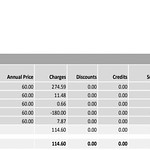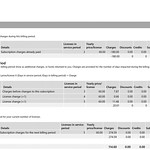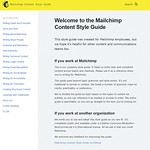Strategic Content Design

Tools and Research Techniques for Better UX
In Strategic Content Design, you’ll learn how content research can transform your content team—bringing new energy and enthusiasm for their work and gaining attention and respect from teams of all types across your company (product management, product design, user research, operations, and engineering). You’ll also get a toolbox with hard-won methods, best practices, and proven tips for conducting quantitative and qualitative content-focused research and testing.
Use this book to:
- Create a strong content research program that builds positive energy, inspires your team, and draws attention to the importance of content to your products and business.
- Determine which methods and tools are ideal for your team’s content research needs.
- Identify which specific words or content elements to test. Efficiently analyze your research results to uncover valuable insights about your audience that will contribute to a measurably improved customer experience (and therefore improved business results).
- Show why content research is worth the time and effort.
- Elevate the role of content design in your company, proving that content is key to creating an outstanding customer experience—and to improving your company’s bottom line by saving your company on costs and increasing revenue.
- Get buy-in and support from colleagues inside and outside of content, leading to improved relationships across teams.
In Strategic Content Design, you’ll learn how content research can transform your content team—bringing new energy and enthusiasm for their work and gaining attention and respect from teams of all types across your company (product management, product design, user research, operations, and engineering). You’ll also get a toolbox with hard-won methods, best practices, and proven tips for conducting quantitative and qualitative content-focused research and testing.
Use this book to:
- Create a strong content research program that builds positive energy, inspires your team, and draws attention to the importance of content to your products and business.
- Determine which methods and tools are ideal for your team’s content research needs.
- Identify which specific words or content elements to test. Efficiently analyze your research results to uncover valuable insights about your audience that will contribute to a measurably improved customer experience (and therefore improved business results).
- Show why content research is worth the time and effort.
- Elevate the role of content design in your company, proving that content is key to creating an outstanding customer experience—and to improving your company’s bottom line by saving your company on costs and increasing revenue.
- Get buy-in and support from colleagues inside and outside of content, leading to improved relationships across teams.
Testimonials
This is me, shouting from the rooftops: Strategic Content Design belongs in the hands of absolutely anyone who cares about content in UX—by which I mean EVERYONE. Erica Jorgensen shows you how to create actionable content standards, put together an effective research plan for better content outcomes, and share your work across your organization
Kristina Halvorson, CEO and Founder, Brain Traffic
Reading Strategic Content Design is like having a personal mentor quickly teach you the most important aspects of content creation and content research. While it would be ideal to have a dedicated user researcher on our projects, it’s extremely valuable for digital teams to know how to gather customer feedback. Many of the insights that Erica shares would take years of experimentation and on-the-job analysis to learn on your own. If you would like to skip ahead to better content, then read this book.
Michelle Mazurek, Senior Manager, User Experience at Amazon
I’m using this book immediately. Its fresh examples and focused research techniques will help my team serve our customers better than ever.
Torrey Podmajersky, author, Strategic Writing for UX
If you’ve been looking for ways to make sure that your content is customer-centered and has real business impact, this is a must-have field guide for content evaluation and testing.
Sheila O’Hara, Head of Content Design, Slack
Yes! This is the book about content design and research I’ve always wanted. From strategy to execution, Erica shows you everything you need to create content that solves real problems for real people.
Jonathon Colman, Content Design Practice Lead at HubSpot
Good content answers our questions. But good content comes from good research—and in Strategic Content Design, Erica Jorgensen brings an astute and unflinching eye to research and testing techniques to engage the people, planning, and processes that shape content. Ready to ask tough questions? Roll up your sleeves; this is a book that prepares you to do the work.
Margot Bloomstein, brand and content strategist and author of Trustworthy: How the Smartest Brands Beat Cynicism and Bridge the Trust Gap
If you’re writing words for a user experience without understanding their impact on your audience, you might as well be writing in a language they don’t understand! Erica Jorgensen’s book gives you all the tools you need to understand your users, measure your writing’s effectiveness, and create clarity and quality. Read this book and go forth to make your users’ lives better through effective content!
Andy Welfle, Coauthor of Writing Is Designing
Erica’s book helps you get actionable insights to write truly user-obsessed content for your digital thing. The guidance and practices she outlines to get those insights and craft useful, usable, even delightful, content will be an indispensable resource … the kind that sits on your desk always at-the-ready when you need it.
Meghan Casey, Owner, Do Better Content Consulting and author of The Content Strategy Toolkit: Methods, Guidelines, and Templates for Getting Content Right
Erica Jorgensen’s guide to research-driven content is packed with ways to get the best out of everyone whose work touches content. It will help any content professional build a strong foundation, navigate past content’s biggest obstacle—unwelcome opinions—and toward content as a team sport that helps a whole organization win.
Jane Ruffino, content design consultant and UX writing course director, Berghs School of Communication, Stockholm, Sweden
Table of Contents
Foreword by Janice (Ginny) Redish
Chapter 1: The Power of Content Research
Chapter 2: Leverage the Power of Clear Content
Chapter 3: Identify Your Content Quality Principles
Chapter 4: Evaluate the State of Your Content
Chapter 5: Identify Your Content Research Goals
Chapter 6: Research Planning and Stakeholder Management
Chapter 7: Craft Your Content Research Questions
Chapter 8: Analyze Content Research Results
Chapter 9: Share Results from Content Research Studies
Chapter 10: More Content Research Techniques
Chapter 11: Apply Insights and Share Business Results
Chapter 12: Build Momentum with Content Research
FAQ
These common questions and their short answers are taken from Erica Jorgensen’s book Strategic Content Design: Tools and Research Techniques for Better UX. You can find longer answers to each in your copy of the book, either printed or digital version.
- Why is research for content design important?
Content research can be directly tied to or correlated with business impact. If you know confidently what words and phrases are prefer- able to your audience and use those words in your content, you’re going to help your company decrease costs (by reducing calls to your customer service department). You’re also going to strengthen the business by creating more revenue, making customers more loyal to your company (increasing customer “long-term value,” or “lifetime value,” or LTV). See Chapter 11, “Apply Insights and Share Business Results.”With this increase in business impact comes greater respect for the role of content creators in your company. That respect, in turn, can lead to many other wonderful things: more attention for your team; opportunities to present the results of your work in business review meetings; a deeper, broader understanding across your company about the importance of content; and better support and recognition for your team, such as more resources, and even increased staffing and promotions.
Sample Chapter
This is a sample chapter from Erica Jorgensen’s book Strategic Content Design: Tools and Research Techniques for Better UX. 2023, Rosenfeld Media.
Chapter 1: The Power of Content Research
Here’s an astonishing example of the power of content research.
While I was working for a major health insurance company, the digital experience team was called into an urgent meeting. We were selling health insurance policies during the national open-enrollment period. That meant we had only 10 weeks to promote and sell health insurance plans. Two weeks into that 10-week window, the senior director of digital experience had alarming news to share: sales were only at a fraction of what was expected. Senior executives at the company were sounding the alarms. We needed to make up for lost time and “fix” the customer experience, immediately. But what was going on? After months of feverish user research with prospective customers, we’d created a visually appealing, simplified customer experience—or so we thought.














